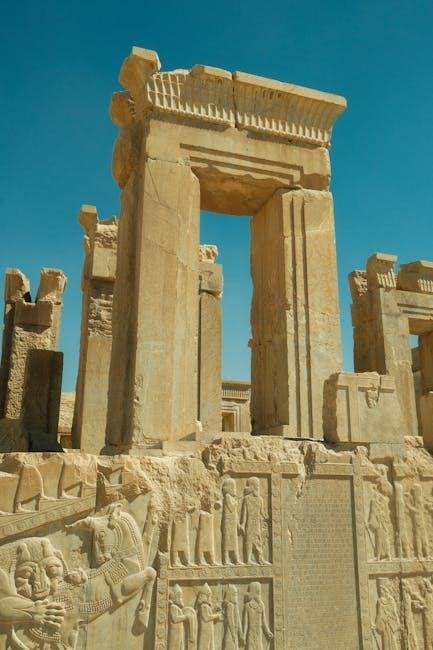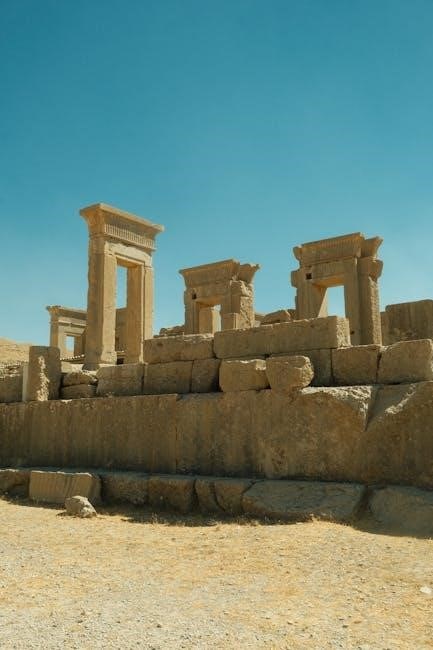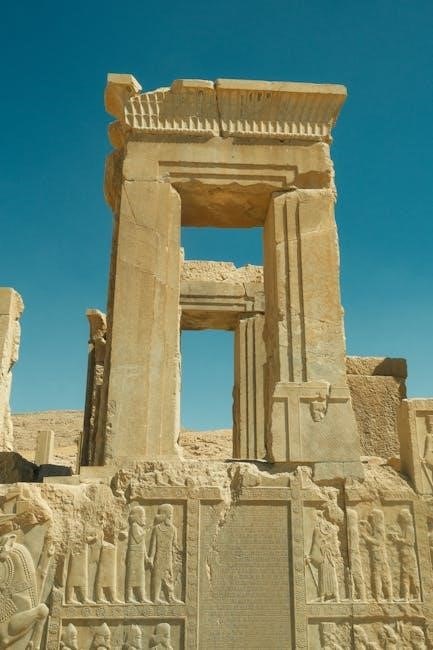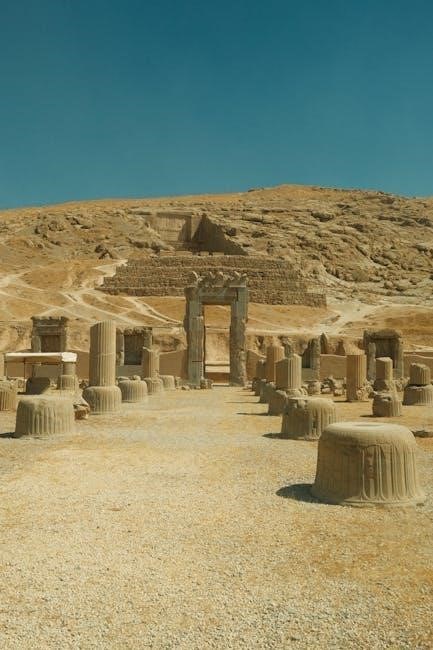Persepolis is a groundbreaking graphic novel by Marjane Satrapi, depicting her childhood in Iran during the Islamic Revolution. The book explores themes of identity, culture, and oppression, offering a unique perspective on life in Iran. Its availability in PDF format has made it widely accessible, allowing readers to connect with Satrapi’s powerful storytelling and visual artistry globally.
1.1 Overview of the Book

Persepolis, a graphic novel by Marjane Satrapi, is an autobiographical account of her childhood in Iran during the Islamic Revolution. The book explores themes of identity, culture, and oppression, blending personal narratives with historical context. Its vivid visuals and poignant storytelling provide a unique perspective on life in Iran during the 1980s. The PDF format has made the book widely accessible, allowing readers to engage with Satrapi’s powerful reflections on belonging, religion, and societal expectations, making it a compelling read for global audiences.
1.2 Importance of the PDF Format
The PDF format of Persepolis has significantly enhanced its accessibility, allowing readers worldwide to access Marjane Satrapi’s work effortlessly. The digital version preserves the graphic novel’s visual integrity, ensuring that the artwork and text remain crisp and clear. This format has also enabled easy sharing and distribution, contributing to the book’s global popularity. Additionally, the PDF version is compatible with various devices, making it convenient for readers to engage with the story anytime and anywhere, thus expanding its reach and impact beyond traditional print formats.
1.3 Brief Biography of Marjane Satrapi
Marjane Satrapi is an Iranian-born French graphic novelist, illustrator, and filmmaker. Born in 1969 in Rasht, Iran, she grew up in Tehran during the Islamic Revolution. Her experiences shaped her acclaimed graphic novel Persepolis, which reflects her journey of self-discovery and cultural identity. Satrapi moved to Europe in her teens, settling in France, where she pursued art and writing. Her work blends personal narratives with historical context, offering a unique perspective on Iran’s tumultuous past and its impact on individual lives. Her contributions have made her a prominent voice in contemporary literature and cinema.

Historical Context
Persepolis is set against the backdrop of the Iranian Revolution and the Iran-Iraq War, exploreing the societal upheaval and political turmoil that shaped modern Iran’s identity and culture.
2.1 The Iranian Revolution
The Iranian Revolution of 1979 marked a pivotal shift, overthrowing the Shah and establishing an Islamic Republic under Ayatollah Khomeini. This period, depicted in Persepolis, brought drastic changes to Iranian society, including the enforcement of strict religious laws and cultural transformations. The revolution’s impact on daily life, politics, and individual freedoms is central to Marjane Satrapi’s narrative, offering a personal lens through which readers can understand the broader historical context and its lasting effects on Iran.
2.2 Life in Iran During the 1980s
Life in Iran during the 1980s was marked by significant societal changes following the Islamic Revolution. The decade saw the enforcement of strict religious laws, including mandatory veiling for women, and a shift toward conservative cultural norms. The Iran-Iraq War further exacerbated tensions, impacting daily life and the economy. Satrapi’s narrative captures the stark contrasts between private family life and the oppressive public sphere, highlighting the challenges of growing up in a society undergoing dramatic transformation and grappling with war and religious ideology.
Themes and Messages
Persepolis explores themes of identity, cultural conflict, and female empowerment, offering a poignant critique of oppression while celebrating resilience and self-discovery in a turbulent Iran.
3.1 Identity and Belonging
In Persepolis, Marjane Satrapi delves into the complexities of identity and belonging, portraying her struggle to reconcile her Iranian heritage with her Western upbringing. The graphic novel vividly illustrates her journey of self-discovery, navigating cultural disparities and societal expectations. Through her experiences, Satrapi highlights the challenges of finding one’s place in a world divided by cultural and political boundaries, making her story relatable to readers facing similar identity conflicts. The PDF format allows these themes to resonate globally, fostering empathy and understanding.
3.2 Cultural and Religious Conflicts
Persepolis vividly portrays the cultural and religious conflicts Marjane Satrapi faced growing up in Iran. The graphic novel explores the tension between traditional Islamic values and modern Western influences, reflecting the societal shifts post-revolution. Satrapi’s personal struggles with faith and identity are juxtaposed with the broader cultural upheaval, providing a poignant commentary on the clash of ideologies. The PDF version captures these themes through its visual and textual narrative, offering readers a profound understanding of the complexities of cultural and religious identity in Iran.
3.4 The Struggle for Women’s Rights
Persepolis highlights Marjane Satrapi’s experiences with gender inequality in Iran. The graphic novel illustrates the oppressive measures imposed on women, such as mandatory veiling, and the societal expectations that confined their roles. Satrapi’s portrayal of her mother’s activism and her own rebellions underscores the resilience of Iranian women in the face of systemic oppression. The PDF format preserves the emotional weight of these stories, allowing readers to visually connect with the struggles and triumphs of women navigating a patriarchal society during and after the Islamic Revolution.

The Graphic Novel Format
Persepolis excels as a graphic novel, with Marjane Satrapi’s black-and-white illustrations enhancing the emotional depth of her story. The visual format allows readers to connect deeply with her experiences, blending text and imagery to convey complex emotions and cultural nuances effectively. The PDF version preserves this unique storytelling style, ensuring accessibility and maintaining the artistic integrity of Satrapi’s work.
4.1 The Role of Visual Storytelling
Persepolis relies heavily on visual storytelling, with Marjane Satrapi’s illustrations conveying complex emotions and cultural nuances. The black-and-white art style simplifies yet intensifies the narrative, making it universally relatable. Through vivid panels, Satrapi depicts her childhood experiences, blending personal and political themes seamlessly. The visual format allows readers to engage deeply with her journey, while the PDF version ensures these images retain their clarity and emotional impact, making the story accessible to a global audience.
4.2 How the Format Enhances the Narrative
The graphic novel format of Persepolis enhances its narrative by blending text and images to create a dynamic storytelling experience. The PDF version preserves this balance, ensuring that Marjane Satrapi’s visual and textual elements remain synchronized. The format allows readers to absorb both the emotional depth of the illustrations and the introspective prose, fostering a deeper connection to Satrapi’s journey. This integration of visual and written content makes the PDF a powerful medium for conveying the complexities of her experiences during the Iranian Revolution and beyond.

Key Chapters and Moments
Persepolis highlights pivotal moments like the imposition of the veil and the impact of war, using vivid visuals to convey Satrapi’s personal and historical journey, making the PDF format impactful.
5;1 The Veil: A Symbol of Oppression
In Persepolis, the veil emerges as a potent symbol of oppression, enforced by the Iranian regime. Marjane Satrapi vividly portrays her resistance to wearing it, reflecting her struggle with cultural identity. The PDF format highlights Satrapi’s artwork, emphasizing the veil’s visual and emotional impact. This chapter underscores the tension between personal freedom and societal expectations, resonating deeply with readers. The veil becomes a metaphor for the broader oppressive regime, illustrating the complexities of life under authoritarian rule and the resilience of individual spirit in the face of systemic control.
5.2 The Impact of War on Daily Life
The Iran-Iraq War profoundly disrupted daily life in Iran, as depicted in Persepolis. Marjane Satrapi illustrates the pervasive fear and uncertainty, with air raid drills and scarcity becoming routine. The war’s psychological toll is evident, particularly on children, as they grappled with the stark contrast between the safety of home and the external chaos. The graphic novel’s visual storytelling, enhanced by the PDF format, vividly portrays these disruptions, offering a poignant reflection of how conflict permeates everyday existence and shapes individual and collective experiences during wartime.
The PDF Version’s Popularity
The PDF format of Persepolis has gained immense popularity due to its easy accessibility and convenience. Readers worldwide prefer the digital version for its portability and seamless readability.
6.1 Accessibility and Reach
The PDF version of Persepolis has significantly broadened its accessibility, allowing readers worldwide to engage with Marjane Satrapi’s story. The digital format eliminates geographical barriers, making it available across different countries and languages. Its compact size and ease of sharing have contributed to its widespread distribution. Additionally, the PDF’s compatibility with various devices ensures that readers can access the book on smartphones, tablets, and computers, further enhancing its reach and impact. This accessibility has played a crucial role in making Persepolis a global phenomenon, touching readers from diverse backgrounds and cultures.
6.2 Why Readers Prefer the Digital Format
Readers favor the digital format of Persepolis for its convenience and accessibility. The PDF version allows for easy storage on devices, enabling readers to carry the book anywhere. Its portability and space-saving nature are significant advantages. Additionally, digital formats often include adjustable font sizes, enhancing readability; The ability to quickly search for specific sections and highlights also appeals to many. Furthermore, the digital version preserves the graphic novel’s visual integrity, ensuring that Marjane Satrapi’s illustrations remain crisp and vibrant. These features make the PDF a preferred choice for modern readers seeking flexibility and ease of access.

Educational Use
The Persepolis PDF is widely used in schools and universities for its educational value, fostering discussions on history, culture, and identity. Its digital format enhances classroom engagement and accessibility, making it a valuable resource for teachers and students alike.
7.1 Incorporation into School Curriculums
The Persepolis PDF has become a staple in educational curriculums worldwide, particularly in literature, history, and cultural studies. Its graphic novel format engages students, fostering deeper understanding of Iran’s history and identity. The digital version is easily distributed, making it accessible for classroom use. Educators praise its ability to provide a personal, relatable perspective on the Iranian Revolution and its aftermath. The book’s themes of identity, culture, and resilience resonate with students, encouraging critical thinking and empathy. Its inclusion in syllabi highlights its educational value as a modern, impactful learning tool.
7.2 Using the PDF for Classroom Discussions
The Persepolis PDF has become a valuable educational tool, enabling teachers to facilitate engaging classroom discussions. Its digital format allows easy sharing and accessibility, ensuring all students can participate. The visual storytelling and text can be projected or viewed on devices, fostering analysis of themes, characters, and historical context. Teachers often use the PDF to highlight key sections or assign digital annotations, encouraging critical thinking and collaboration. This format also supports online discussions, making it ideal for remote learning environments, while maintaining the book’s emotional and educational impact on students.

Reception and Reviews
Persepolis has received widespread critical acclaim for its powerful storytelling and cultural insight, becoming a feminist manifesto and a beloved graphic novel, with its PDF version widely downloaded.
8.1 Critical Acclaim
Critical acclaim for Persepolis highlights its profound impact as a graphic novel. Reviewers praise Marjane Satrapi’s ability to weave personal and political narratives seamlessly, making the PDF version a sought-after resource for its accessibility and readability. The vivid visuals and heartfelt storytelling have earned it a place as a classroom staple and a feminist manifesto, resonating deeply with readers worldwide who appreciate its nuanced portrayal of life in Iran during the Islamic Revolution.
8.2 Reader Feedback and Ratings
Readers worldwide have praised Persepolis for its raw honesty and emotional depth, with high ratings across platforms. The PDF version has been particularly popular, offering easy access to Satrapi’s vivid storytelling. Many readers highlight its ability to bridge cultural gaps, resonating with diverse audiences. The graphic novel is frequently recommended for its unique perspective on identity and societal challenges, making it a cherished and thought-provoking read for millions. Its relatability and impact continue to drive its popularity in both digital and print formats.
Comparisons and Adaptations
Persepolis was adapted into an animated film, bringing Satrapi’s story to life visually while maintaining its emotional depth and cultural authenticity, enhancing the narrative’s global reach and impact.
9.1 The Movie Adaptation
The film adaptation of Persepolis, directed by Marjane Satrapi and Vincent Paronnaud, beautifully translates the graphic novel into an animated masterpiece. It captures the essence of Satrapi’s journey, blending poignant storytelling with striking visuals. The movie stays true to the book’s themes of identity, cultural conflict, and personal growth, while introducing these elements to a broader audience. The adaptation received widespread acclaim for its unique animation style and emotional resonance, further cementing Persepolis as a timeless and universal story.
9.2 Differences Between Book and Film
While the film adaptation of Persepolis remains largely faithful to the book, some differences exist. The graphic novel provides more detailed visual storytelling and personal reflections, while the film simplifies certain narratives for cinematic pacing. The book delves deeper into Marjane’s experiences in Austria, which are less explored in the movie. Additionally, the film’s black-and-white animation offers a distinct visual style compared to the book’s original artwork. These differences highlight the unique strengths of each medium in conveying Satrapi’s powerful story.
Personal Stories and Reflections
Persepolis offers intimate glimpses into Marjane Satrapi’s childhood in Iran, reflecting her struggles with identity, family, and cultural expectations during the Islamic Revolution, shaping her unique worldview.
10.1 Satrapi’s Childhood Experiences
Marjane Satrapi’s childhood in Iran was marked by cultural contradictions and political turmoil. Growing up in Tehran during the Islamic Revolution, she faced strict societal norms and family expectations. Her experiences, depicted in Persepolis, reveal a young girl navigating identity, tradition, and modernity. The PDF format of the book captures her vivid memories, offering readers insight into her formative years and the influences that shaped her perspective on life, religion, and societal roles.
10.2 How Her Upbringing Shaped the Book
Marjane Satrapi’s upbringing profoundly influenced Persepolis, as her unique blend of Iranian heritage and Western exposure shaped its narrative. Her family’s liberal values and the oppressive regime’s constraints fueled her exploration of identity and freedom. The PDF version captures her reflections on childhood, blending personal and political themes. This duality enriches the story, making it a poignant memoir that resonates universally, while staying true to her cultural roots and experiences.
Challenges and Controversies
The Persepolis book in PDF format has faced bans and censorship attempts due to its frank portrayal of cultural and political issues, conflicting with traditional values in some regions.
11.1 Censorship Issues
The Persepolis book in PDF format has faced censorship challenges globally due to its depiction of cultural and political issues. Some regions have banned or restricted access to the book, citing concerns over its content, particularly regarding religious and societal critiques. Despite this, the PDF version has remained widely accessible, allowing readers to engage with Satrapi’s story. These censorship attempts have sparked debates about freedom of expression and the importance of diverse perspectives in literature.
11.2 bans and Restrictions
11.2 Bans and Restrictions
The Persepolis book in PDF format has faced bans in certain regions due to its controversial content. Some governments and institutions have restricted access, citing cultural or religious sensitivities. Despite these restrictions, the digital format has allowed readers to access the book, highlighting the challenges of controlling information in the digital age. These bans have drawn attention to the book’s themes, sparking debates about censorship and freedom of expression. The PDF version remains a vital resource for readers seeking unfiltered access to Satrapi’s story.

Legacy and Impact
The Persepolis PDF has left a lasting legacy, influencing graphic novels globally. Its cultural significance and accessibility have made it a cornerstone of contemporary literature, inspiring new storytelling approaches.
12.1 Influence on Graphic Novels

Persepolis revolutionized graphic novels by blending personal narrative with historical context. Its PDF format has democratized access, inspiring creators to explore non-traditional storytelling. The book’s success has paved the way for diverse voices in the genre, proving that visual narratives can convey deep emotional and political complexity. As a result, Persepolis is often cited as a benchmark, influencing a new wave of graphic novelists to share their unique perspectives and cultural experiences with global audiences.

12.2 Cultural and Social Impact
Persepolis has had a profound cultural and social impact, challenging stereotypes about Iran and fostering cross-cultural understanding. Its PDF availability has enabled global readers to engage with Satrapi’s story, sparking conversations about identity, freedom, and resilience. The book has become an educational tool, promoting empathy and reducing cultural divides. By sharing her experiences, Satrapi has inspired others to explore their own histories, making Persepolis a pivotal work in bridging cultural gaps and encouraging social change worldwide.
